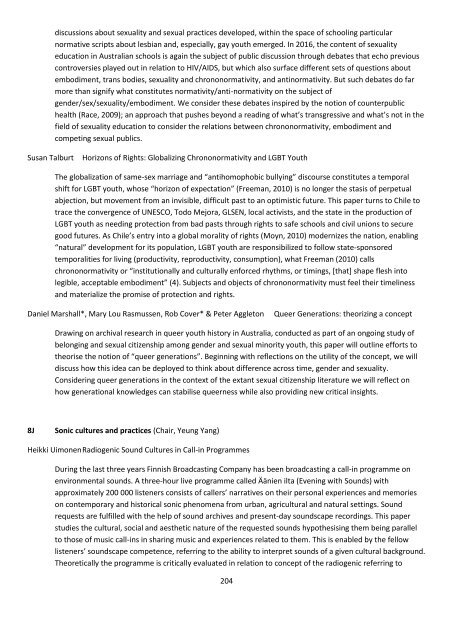Crossroads in Cultural Studies Conference 14-17th December 2016 Program Index
Crossroads-2016-final-draft-program-30-Nov
Crossroads-2016-final-draft-program-30-Nov
Create successful ePaper yourself
Turn your PDF publications into a flip-book with our unique Google optimized e-Paper software.
discussions about sexuality and sexual practices developed, with<strong>in</strong> the space of school<strong>in</strong>g particular<br />
normative scripts about lesbian and, especially, gay youth emerged. In <strong>2016</strong>, the content of sexuality<br />
education <strong>in</strong> Australian schools is aga<strong>in</strong> the subject of public discussion through debates that echo previous<br />
controversies played out <strong>in</strong> relation to HIV/AIDS, but which also surface different sets of questions about<br />
embodiment, trans bodies, sexuality and chrononormativity, and ant<strong>in</strong>ormativity. But such debates do far<br />
more than signify what constitutes normativity/anti-normativity on the subject of<br />
gender/sex/sexuality/embodiment. We consider these debates <strong>in</strong>spired by the notion of counterpublic<br />
health (Race, 2009); an approach that pushes beyond a read<strong>in</strong>g of what’s transgressive and what’s not <strong>in</strong> the<br />
field of sexuality education to consider the relations between chrononormativity, embodiment and<br />
compet<strong>in</strong>g sexual publics.<br />
Susan Talburt<br />
Horizons of Rights: Globaliz<strong>in</strong>g Chrononormativity and LGBT Youth<br />
The globalization of same-sex marriage and “antihomophobic bully<strong>in</strong>g” discourse constitutes a temporal<br />
shift for LGBT youth, whose “horizon of expectation” (Freeman, 2010) is no longer the stasis of perpetual<br />
abjection, but movement from an <strong>in</strong>visible, difficult past to an optimistic future. This paper turns to Chile to<br />
trace the convergence of UNESCO, Todo Mejora, GLSEN, local activists, and the state <strong>in</strong> the production of<br />
LGBT youth as need<strong>in</strong>g protection from bad pasts through rights to safe schools and civil unions to secure<br />
good futures. As Chile’s entry <strong>in</strong>to a global morality of rights (Moyn, 2010) modernizes the nation, enabl<strong>in</strong>g<br />
“natural” development for its population, LGBT youth are responsibilized to follow state-sponsored<br />
temporalities for liv<strong>in</strong>g (productivity, reproductivity, consumption), what Freeman (2010) calls<br />
chrononormativity or “<strong>in</strong>stitutionally and culturally enforced rhythms, or tim<strong>in</strong>gs, [that] shape flesh <strong>in</strong>to<br />
legible, acceptable embodiment” (4). Subjects and objects of chrononormativity must feel their timel<strong>in</strong>ess<br />
and materialize the promise of protection and rights.<br />
Daniel Marshall*, Mary Lou Rasmussen, Rob Cover* & Peter Aggleton<br />
Queer Generations: theoriz<strong>in</strong>g a concept<br />
Draw<strong>in</strong>g on archival research <strong>in</strong> queer youth history <strong>in</strong> Australia, conducted as part of an ongo<strong>in</strong>g study of<br />
belong<strong>in</strong>g and sexual citizenship among gender and sexual m<strong>in</strong>ority youth, this paper will outl<strong>in</strong>e efforts to<br />
theorise the notion of “queer generations”. Beg<strong>in</strong>n<strong>in</strong>g with reflections on the utility of the concept, we will<br />
discuss how this idea can be deployed to th<strong>in</strong>k about difference across time, gender and sexuality.<br />
Consider<strong>in</strong>g queer generations <strong>in</strong> the context of the extant sexual citizenship literature we will reflect on<br />
how generational knowledges can stabilise queerness while also provid<strong>in</strong>g new critical <strong>in</strong>sights.<br />
8J<br />
Sonic cultures and practices (Chair, Yeung Yang)<br />
Heikki Uimonen Radiogenic Sound Cultures <strong>in</strong> Call-<strong>in</strong> <strong>Program</strong>mes<br />
Dur<strong>in</strong>g the last three years F<strong>in</strong>nish Broadcast<strong>in</strong>g Company has been broadcast<strong>in</strong>g a call-<strong>in</strong> programme on<br />
environmental sounds. A three-hour live programme called Äänien ilta (Even<strong>in</strong>g with Sounds) with<br />
approximately 200 000 listeners consists of callers’ narratives on their personal experiences and memories<br />
on contemporary and historical sonic phenomena from urban, agricultural and natural sett<strong>in</strong>gs. Sound<br />
requests are fulfilled with the help of sound archives and present-day soundscape record<strong>in</strong>gs. This paper<br />
studies the cultural, social and aesthetic nature of the requested sounds hypothesis<strong>in</strong>g them be<strong>in</strong>g parallel<br />
to those of music call-<strong>in</strong>s <strong>in</strong> shar<strong>in</strong>g music and experiences related to them. This is enabled by the fellow<br />
listeners’ soundscape competence, referr<strong>in</strong>g to the ability to <strong>in</strong>terpret sounds of a given cultural background.<br />
Theoretically the programme is critically evaluated <strong>in</strong> relation to concept of the radiogenic referr<strong>in</strong>g to<br />
204


